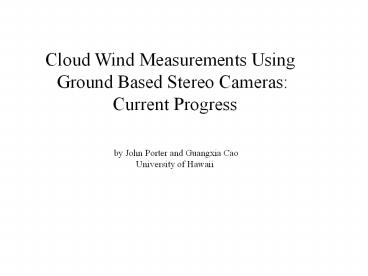Cloud Wind Measurements Using - PowerPoint PPT Presentation
Title:
Cloud Wind Measurements Using
Description:
2) Soundings provide measurements at only one point and time ... Mechanical design for moving shadow band in now being machined ... – PowerPoint PPT presentation
Number of Views:12
Avg rating:3.0/5.0
Title: Cloud Wind Measurements Using
1
Cloud Wind Measurements Using Ground Based
Stereo Cameras Current Progress by John
Porter and Guangxia Cao University of Hawaii
2
There is a need for improved wind measurements
1) Measurements of winds aloft are scarce 2)
Soundings provide measurements at only one point
and time 3) Winds derived from satellite cloud
tracking Resolutions greater than 1 km Cloud
height is not resolved well Cannot provide low
level winds when cirrus is present
3
Trade winds clouds are often ideal for cloud
tracking (show movie of cloud images over
Honolulu)
4
In order to make accurate wind measurements from
a surface based stereo camera system,
Requirements Obtain good images with the sun
blocked (custom shadow band) Camera
internally calibrated (know azimuth and zenith
angles for each pixel) Know the orientation of
the camera (use external reference
points) Determine similar cloud features in both
cameras (spatial correlation) Determining the
cloud position and height at each time
(iterative approach) Correct computer time
(GPS sync to within 10 msec) Fast computer
5
Initial Tests Camera Internal Calibration
(Azimuth and zenith angles for each camera
pixel) Use existing software to calibrate the
camera
Pixel Zenith Angles
Pixel Azimuth Angles
6
Initial Tests Can we track individual cloud
features in sequential images? YES Using two
cloud images, sectors of the image were tracked
using spatial correlation. Calculated wind
vectors are overlain on one of the images.
7
Initial Tests Determine Cloud Position From
Stereo Cameras ? Simulate a cloud and test an
iterative approach to retrieve cloud position
from calibrated cameras. Although not
explained fully here, this study found that the
expected errors will not be large and we will be
able to retrieve cloud positions accurately
from ground based stereo cameras
8
We are now in the final stages of testing and
expect our first results by the end of
December Software has been developed (or
obtained) for Camera internal calibration Camera
orientation Cloud position (x,y,z)
Identifying and tracking cloud features in
different images Mechanical design for moving
shadow band in now being machined Continual GPS
computer time correction to less than 10 ms
implemented
9
Would be ideal to set Cloud Wind Sensors on
remote sites where communication infrastructure
already exists Possibilities Global
Seismographic Network http//www.iris.washington.e
du/about/GSN/ TOGA Sea Level
Network http//ilikai.soest.hawaii.edu/RSL/































